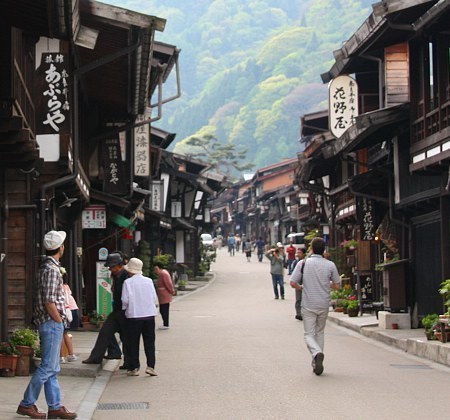Post Towns
by Francois, staff writer of japan-guide.com
| previous post |
| next post |
2008/06/09 - Post Towns

Thanks to the Shinkansen and the public transportation system, getting around in Japan is a convenient, efficient, and usually rapid affair. Despite this, sometimes I catch myself wallowing in self-pity for catching a bad connection or being stuck in a packed train. To snap myself out of it, there is always a simple solution; think of how people would have had to make the trip during the Edo Era. In the Edo Era, if a man wanted to get from Osaka to Tokyo he had to walk.
As a means to assert control over the country, the Shogunate government of the Edo Era heavily restricted the movement of its subjects. For all but the most wealthy, this resulted in journeys being taken by foot across a nationwide system of walking paths. Because these trips would usually require multiple days, "post towns" developed along the routes to provide travellers with accommodation.
Many locations in modern day Japan were first established as post towns, and this can be recognized by place names that end with "-juku"; two well known examples are Tokyo's Shinjuku and Harajuku. But neither of these places have retained much of the post town ambience that they had in the Edo Era. In fact, after the Meiji Restoration and the development of the railway system, most post towns lost their "post town ambience" as they modernized. However, there were also many that did not modernize. As the rest of the country progressed, some former post towns were left behind as relics of a bygone era.

The misfortune of neglected post towns 100 years ago has become our good fortune today. In a few picturesque towns that time seems to have passed over, the post town is still alive. Or rather, to be more precise, the post towns have been revived as a tourist destintation. Of course, people aren't passing through out of necessity anymore, and their journey will probably be just a few hours, at most a weekend . But nonetheless, people are still walking through these little towns, trying to find a bit of rest and revitalization. And in fact, what better way to find refuge from the trials of modern day life than to go to a place where it seems to have not yet arrived.
Some post towns retain their original Honjin and Wakihonjin, which were the principal and secondary inns respectively. When important government officials (or perhaps the Emperor himself) would pass through a town with retinue in tow, it would be there that they would stay. The people of the town and the staff at the inn would go to great lengths to keep their guests comfortable and rested. Modern day travellers may not be greeted with quite the same pomp, but post towns will surely have either ryokan or minshuku where visitors can rest and be tended to if they wish to spend the night. I have had some very enjoyable experiences in the former post towns of Tsumago, Magome, Narai (all in the Kiso Valley), and Ouchijuku.

Though staying at a ryokan is almost always an extremely pleasant experience, the particular pleasure of visiting a post town is undoutedly walking about the town itself. The buildings of the main street are usually kept as they were in the Edo Era, and people sell local specialties out of their shops, sometimes the same speciality that was sold in former times. Many of the old buildings have had their interiors turned into charming little restaurants.
But simply walking up and down the streets is pleasure enough in and of itself. After spending so much of our days behind a desk or behind a wheel, there is something very calming about walking through a quiet old street. One particularly nice walk is between the two post towns of Tsumago and Magome, which has a nicely maintained trail. I suppose if you're in a post town the most natural thing to do is to walk to the next one.

| previous post |
| next post |